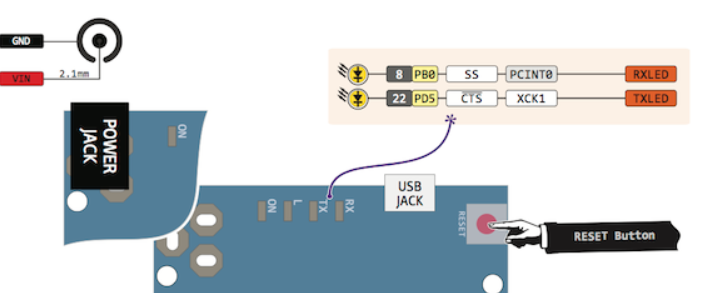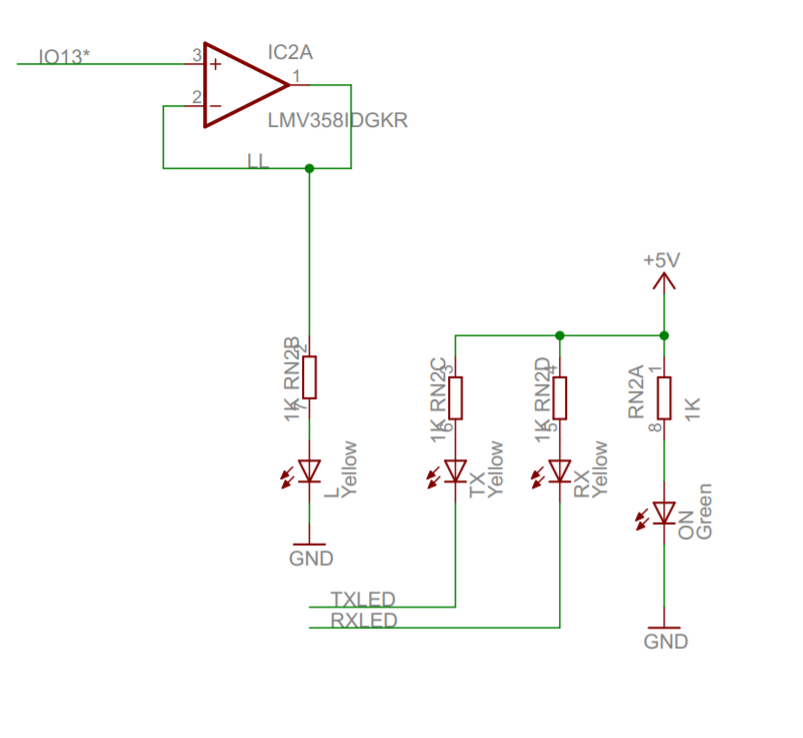正经的 Arduino Leonardo 上面有四个LED(DFrobot 的Leonardo&XBEE V1.2 上面有5个LED)。长得是下面这个样子:
对照电路图 LED 连接如下:
LED 控制Pin 说明
L D13 (PC7) GPIO 控制
TX PD5 USB发送数据亮
RX PB0 USB接收数据亮
ON 5V 上电就亮
初始化在 \arduino-1.8.4\hardware\arduino\avr\cores\arduino\USBCore.cpp 有定义
void USBDevice_::attach()
{
_usbConfiguration = 0;
_usbCurrentStatus = 0;
_usbSuspendState = 0;
USB_ClockEnable();
UDINT &= ~((1<<WAKEUPI) | (1<<SUSPI)); // clear already pending WAKEUP / SUSPEND requests
UDIEN = (1<<EORSTE) | (1<<SOFE) | (1<<SUSPE); // Enable interrupts for EOR (End of Reset), SOF (start of frame) and SUSPEND
TX_RX_LED_INIT;
#if MAGIC_KEY_POS != (RAMEND-1)
if (pgm_read_word(FLASHEND - 1) == NEW_LUFA_SIGNATURE) {
_updatedLUFAbootloader = true;
}
#endif
}
其中的 一些宏定义在 \arduino-1.8.4\hardware\arduino\avr\variants\leonardo\pins_arduino.h
#define TX_RX_LED_INIT DDRD |= (1<<5), DDRB |= (1<<0) #define TXLED0 PORTD |= (1<<5) #define TXLED1 PORTD &= ~(1<<5) #define RXLED0 PORTB |= (1<<0) #define RXLED1 PORTB &= ~(1<<0)
Tx/Rx 的作用是用来指示传输,而实际上传输是一下就发生和结束的,因此,设计上使用了一个延时
/** Pulse generation counters to keep track of the number of milliseconds remaining for each pulse type */ #define TX_RX_LED_PULSE_MS 100 volatile u8 TxLEDPulse; /**< Milliseconds remaining for data Tx LED pulse */ volatile u8 RxLEDPulse; /**< Milliseconds remaining for data Rx LED pulse */
当收到数据时,就Enable Led,同时重置计时器
static inline void Recv(volatile u8* data, u8 count)
{
while (count--)
*data++ = UEDATX;
RXLED1; // light the RX LED
RxLEDPulse = TX_RX_LED_PULSE_MS;
}
static inline u8 Recv8()
{
RXLED1; // light the RX LED
RxLEDPulse = TX_RX_LED_PULSE_MS;
return UEDATX;
}
在每一个 SOF 的时候检查LED
// Start of Frame - happens every millisecond so we use it for TX and RX LED one-shot timing, too
if (udint & (1<<SOFI))
{
USB_Flush(CDC_TX); // Send a tx frame if found
// check whether the one-shot period has elapsed. if so, turn off the LED
if (TxLEDPulse && !(--TxLEDPulse))
TXLED0;
if (RxLEDPulse && !(--RxLEDPulse))
RXLED0;
}
例子:
arduino-1.8.4\hardware\arduino\avr\variants\leonardo\pins_arduino.h
#define NUM_DIGITAL_PINS 31
#define NUM_ANALOG_INPUTS 12
/*
#define TX_RX_LED_INIT DDRD |= (1<<5), DDRB |= (1<<0)
#define TXLED0 PORTD |= (1<<5)
#define TXLED1 PORTD &= ~(1<<5)
#define RXLED0 PORTB |= (1<<0)
#define RXLED1 PORTB &= ~(1<<0)
*/
//labz_Start
#define TX_RX_LED_INIT DDRD |= (1<<5), DDRB |= (1<<0),DDRF = 0x81
#define TXLED0 PORTD |= (1<<5);PORTF &= ~ 0x01
#define TXLED1 PORTD &= ~(1<<5);PORTF |= 0x01
#define RXLED0 PORTB |= (1<<0);PORTF &= ~ 0x80
#define RXLED1 PORTB &= ~(1<<0);PORTF |= 0x80
// labz _End
#define PIN_WIRE_SDA (2)
#define PIN_WIRE_SCL (3)
// the setup function runs once when you press reset or power the board
void setup() {
// initialize digital pin LED_BUILTIN as an output.
pinMode(LED_BUILTIN, OUTPUT);
}
// the loop function runs over and over again forever
void loop() {
while (Serial.available())
{ byte c=Serial.read();
Serial.write(c);
}
}
参考:
1.Leonardo 电路图
https://www.arduino.cc/en/uploads/Main/arduino-leonardo-schematic_3b.pdf
2.引脚关系
http://www.zembedded.com/wp-content/uploads/2013/04/Ardunio_leonardo.png

